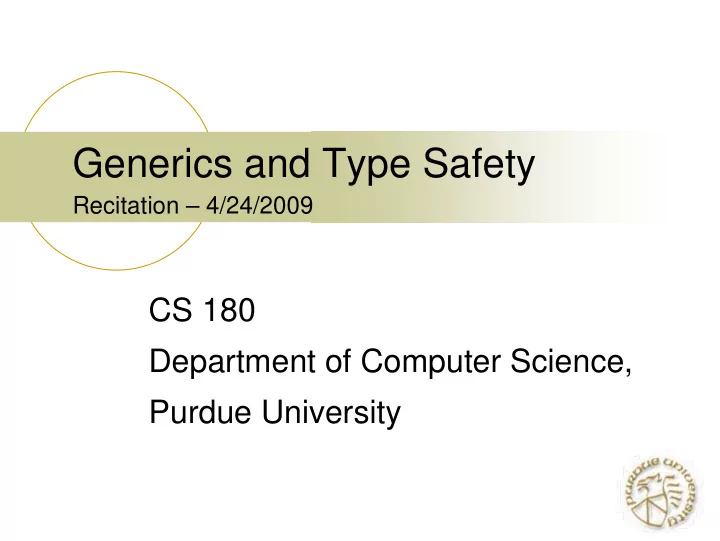

Generics and Type Safety Recitation – 4/24/2009 CS 180 Department of Computer Science, Purdue University
Announcement � Project 8 due Wed, April 29 at 10 pm. � All questions on the class newsgroup.
Generics Motivation � In Java, array elements must all be of the same type: � int[] counts = new int[10]; � Hence, arrays are type safe : The compiler will not let you put the wrong kind of thing into an array � A collection, such as a Vector or the non- parameterized ArrayList, cannot hold primitives, but will accept any type of Obj ect: � ArrayList someS tuff = new ArrayList(); someS tuff.add("A S tring is an Obj ect"); someS tuff.add(10); � Is not type safe; Making a collection type safe is a tedious process
Generics � J2SE 5.0 provides compile-time type safety with the Java Collections framework through generics � Generics allows you to specify, at compile-time, the types of objects you want to store in a Collection. Then when you add and get items from the list, the list already knows what types of objects are supposed to be acted on � So you don't need to cast anything. The " <> " characters are used to designate what type is to be stored. If the wrong type of data is provided, a compile-time exception is thrown.
Problem: Develop a Roster � Purdue need rosters for undergraduate students , graduate students and employees. � Each department needs rosters for their students and employees. Suppose there are ten departments. � How many roster classes do we need to write?
Raw Solution � The simplest solution is: � Write a class Roster which accept Objects. � We can have three objects: undergraduateRoster, graduateRoster and employeeRoster. � We can manually make sure correct objects are put in correct rosters. � When we get data from a roster, type casting is needed. � If someone add an Integer to graduateRoster by mistake, what happens?
Inheritance Solution � An intuitive solution after learning inheritance is like this: � Write a super class Roster. � Write three subclasses UndergraduateRoster, GraduateRoster and EmployeeRoster. � In EmployeeRoster, Student objects are not accepted. � It looks reasonable, but what happens if a new roster like TARoster is needed? What happens if ten more different rosters are needed?
Generics Solution � Now we use generics to solve it. � Write a class Roster<T>. � If we want a roster of undergraduate students, we can use Roster<UndergraduateStudent>. � What’s the benefit here? � Easy to add new rosters. � Only need one class. � Do not accept incompatible objects. � Still has flexibility: Roster<Student> can accept UndergraduateStudent and GraduateStudent objects.
Some Issues about It � We can define a Roster<T extends Person> to make sure all rosters can do something with class Person. � What’s the relationship between Roster<Student> and Roster<GraduateStudent>? � Roster<Student> studentRoster = new Roster<GraduateStudent>(); correct?
Problem not Solved Yet! � Each department needs rosters for their students and employees. � Do we need Roster<T1, T2>, T1 for student or employee and T2 for department? � What do you think? � Remember Roster<GraduateStudent, CS> has no relationship with Roster<GraduateStudent, CE>.
Generics, Inheritance and Interface � A subclass of a generic class must be a generic class. � The super class of a generic class may not be a generic class. � Object class is a good example. � A generic interface can only be implemented by corresponding generic class. � A generic class can implement non-generic interface.
Raw Types � A generic class can be used to produce different classes like Roster<T> described previously. � However, Java still allow the declaration of Roster objects. � Roster rawRoster = new Roster(); � This roster may contain any kind of objects like Integer, Circle, Car… � If we have Roster<T extends Person>, can it still accept any kinds of objects? � No!
Quiz � If you are required to deal with complex numbers (a + bi). � If a and b should have the same type but they can be Integer, Long, Float or Double. How will you define your classes? � If a and b may not have the same type, what would you do? � No need to write a complete class definition.
Recommend
More recommend